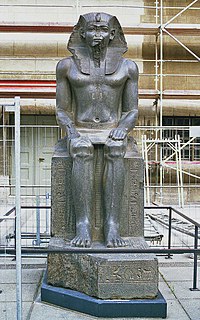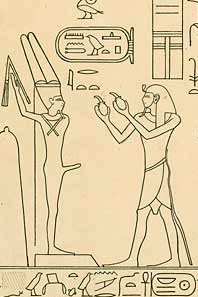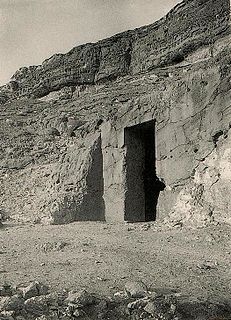
Amenemhat III, also spelled Amenemhet III, was a pharaoh of the Twelfth Dynasty of Egypt. He ruled from c. 1860 BC to c. 1814 BC, the highest known date being found in a papyrus dated to Regnal Year 46, I Akhet 22 of his rule. His reign is regarded as the golden age of the Middle Kingdom. He may have had a long coregency with his father, Senusret III.

The Middle Kingdom of Egypt is the period in the history of ancient Egypt following a period of political division known as the First Intermediate Period. The Middle Kingdom lasted from approximately 2050 to 1710 BC, stretching from the reunification of Egypt under the reign of Mentuhotep II in the Eleventh Dynasty to the end of the Twelfth Dynasty. The kings of the Eleventh Dynasty ruled from Thebes and the kings of the Twelfth Dynasty ruled from el-Lisht.

Sobekneferu reigned as pharaoh of Egypt after the death of Amenemhat IV. She was the last ruler of the Twelfth Dynasty of Egypt and ruled Egypt for almost four years from 1806 to 1802 BC. Her name means "the beauty of Sobek."

The Twelfth Dynasty of ancient Egypt is often combined with the Eleventh, Thirteenth and Fourteenth Dynasties under the group title Middle Kingdom.

The Eleventh Dynasty of ancient Egypt is a well-attested group of rulers. Its earlier members before Pharaoh Mentuhotep II are grouped with the four preceding dynasties to form the First Intermediate Period, whereas the later members are considered part of the Middle Kingdom. They all ruled from Thebes in Upper Egypt.

Amenemhat IV was the seventh and penultimate pharaoh of the 12th Dynasty of Egypt during the late Middle Kingdom period, ruling for over nine years in the late 19th century BC or the early 18th century BC.

Amenemhat I also Amenemhet I and the hellenized form Ammenemes, was the first ruler of the Twelfth Dynasty, the dynasty considered to be the golden-age of the Middle Kingdom of Egypt. He ruled from 1991 BC to 1962 BC.

Nubkaure Amenemhat II was the third pharaoh of the 12th Dynasty of ancient Egypt. Although he ruled for at least 35 years, his reign is rather obscure, as well as his family relationships.

Senusret I also anglicized as Sesostris I and Senwosret I, was the second pharaoh of the Twelfth Dynasty of Egypt. He ruled from 1971 BC to 1926 BC, and was one of the most powerful kings of this Dynasty. He was the son of Amenemhat I. Senusret I was known by his prenomen, Kheperkare, which means "the Ka of Re is created."

Nebtawyre Mentuhotep IV was the last king of the 11th Dynasty. He seems to fit into a 7-year period in the Turin Canon for which there is no recorded king.

The vizier was the highest official in ancient Egypt to serve the pharaoh (king) during the Old, Middle, and New Kingdoms. Vizier is the generally accepted rendering of ancient Egyptian tjati, tjaty etc., among Egyptologists. The Instruction of Rekhmire, a New Kingdom text, defines many of the duties of the tjaty, and lays down codes of behavior. The viziers were often appointed by the pharaoh. During the 4th Dynasty and early 5th Dynasty, viziers were exclusively drawn from the royal family; from the period around the reign of Neferirkare Kakai onwards, they were chosen according to loyalty and talent or inherited the position from their fathers.
Amenemhatankh was an ancient Egyptian prince of the 12th Dynasty, son of Amenemhat II.

Siese was a vizier and treasurer of the Twelfth Dynasty of Egypt. He was most likely in office under Amenemhat II.
Kheti was an Ancient Egyptian vizier of the Twelfth Dynasty under king Amenemhet III, around 1800 BC. Kheti is known from a papyrus fragment dated to year 29 of that king. He is the only vizier who can be specifically dated to the rule of Amenemhat III. In the Installation of the Vizier, a text referring to the office of the vizier, found in several New Kingdom tombs, there is mentioned a famous vizier named Kheti. About him is said: He impoverished his associates for the benefits of others. It seems possible that both sources refer to the same person.
Ameny was an ancient Egyptian vizier under Middle Kingdom king Amenemhat II, around 1900 BC, in the Twelfth Dynasty. Ameny appears on the fragment of an annal stone of the king. The fragment was found by Flinders Petrie in Memphis and mentions a statue of this vizier. Ameny is perhaps also known from an offering table. However, the name Ameny belongs to the most common names of the Middle Kingdom. Therefore, the identity of both people on these objects is far from certain.

Zamonth or Samont was an Ancient Egyptian vizier who was in office at the end of the Twelfth Dynasty, around 1800 BC.

Sebkay was an ancient Egyptian pharaoh during the Second Intermediate Period. For a long time his position created problems and he was most often placed into the 13th Dynasty. However, the discovery of the tomb of a king with the name Senebkay make it very likely that Sebkay is identical with the latter and the writing of the name Sebkay is just a misspelling of the name.

Segerseni was an ancient Egyptian or Nubian chieftain of Nubia, likely reigning concurrently with the end of the 11th and beginning of the 12th Dynasty during the early Middle Kingdom.

Khnumhotep I was an ancient Egyptian Great Chief of the Oryx nome during the reign of Pharaoh Amenemhat I of the 12th Dynasty, Middle Kingdom.
Seankhibtawy Seankhibra is the name of an Ancient Egyptian king of the 11th or more likely the 12th or 13th Dynasty of Egypt, during the Middle Kingdom period. As of 2018, Seankhibtawy Seankhibra is only known from a single architrave found at Ayn Shams, the ancient city of Heliopolis, where it once adorned a private tomb. It is unclear whether Seankhibtawy Seankhibra is an otherwise unknown king or is rather a name variant for another, better known king of the 12th or 13th Dynasty.















